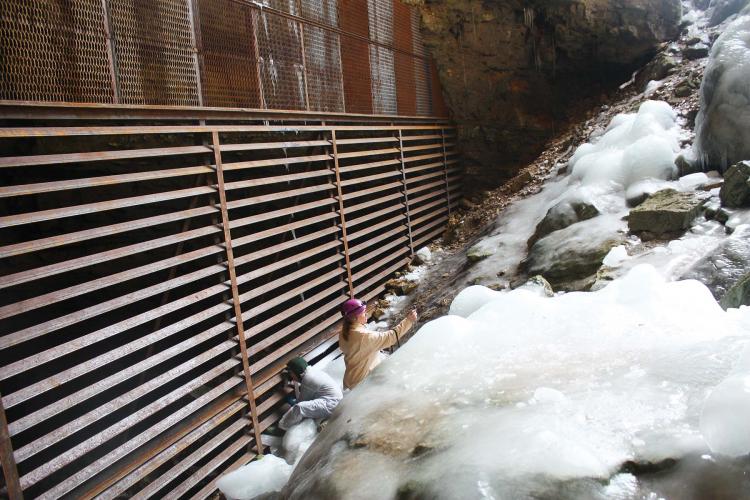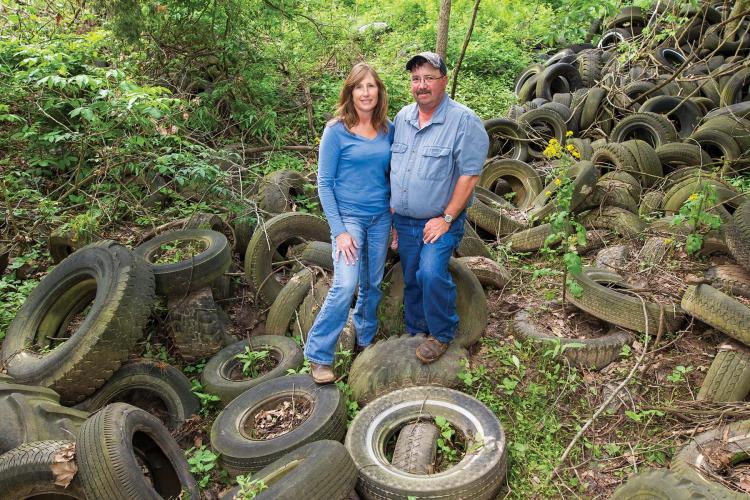Karst. It isn’t a word you hear every day, but it’s the most common kind of geology found in Missouri. Karst is a region of porous limestone containing deep fissures and sinkholes. It also has underground caves and streams, and it’s where much of our drinking water collects, gets filtered, and flows. Karst is also a special kind of habitat that many kinds of native plants and animals can’t live without.
To help keep Missouri’s critical karst and cave habitat healthy, the Department is working with a wide range of partners at several locations. Following are just a few of the many cave and karst conservation projects underway.
Gathering to Gate the Bat Cave
Bat Cave in Shannon County is the third largest gray bat hibernaculum in Missouri. Every October, up to 60,000 bats gather there to conserve energy for the winter. Bat Cave is also critical habitat for the endangered Indiana bat. Other species known to hibernate in this cave are the little brown bat, eastern small-footed bat, tri-colored bat, big brown bat, and the now federally threatened northern long-eared bat.
The property, which has become part of Sunklands Conservation Area, lies next to Current River State Park and is within view of the National Park Service Ozark National Scenic Riverways (ONSR).
The cave’s location on a busy recreation route and itslarge opening above the Current River made it an easy target for vandalism, even after managers fenced it. In 2012, partners from several organizations constructed a proper, bat-friendly cave gate, which is now the largest standing cave gate in the United States.
“It takes partnerships like this to pull off big projects that can truly protect important cave sites,” Resource Scientist Tony Elliott said.
Missouri Department of Conservation led the project with support from a U.S. Fish and Wildlife Service (USFWS) White-Nose Syndrome Grants to States award. Other conservation partners include AmeriCorps, Karst Solutions (Jerry Fant and crew), Missouri Department of Natural Resources State Parks Division, ONSR, and The Nature Conservancy.
Keeping Cattle Out of the Spring
Perry County is a sinkhole plain with many karst features such as caves and losing streams. It is also home to the only known populations of grotto sculpin, a federally endangered fish. Protecting this rare cave-dwelling fish depends on protecting its sensitive karst habitat and improving water quality.
Much of the Perry County karst region is privately owned, so conservation partners work closely with landowners, providing technical assistance and cost-share funds, hosting workshops, and monitoring the area’s valuable karst resources.
Recently, conservation partners took part in a landowner- assistance project to improve spring health and increase efficiency and cleanliness of livestock watering. The project’s objective was to divert spring water through a gravity-fed system and into a livestock watering tank, which, when full, overflowed back into the spring branch. In addition, partners fenced the spring and its branch to exclude livestock access.
“This project is a win-win for karst habitat and for the landowner,” said Department Fisheries Biologist Jason Crites. “The spring has been protected from the livestock, and the livestock now have a clean, reliable drinking water supply.”
In addition to the Department, conservation partners include the Farm Service Agency (FSA), Natural Resources Conservation Service (NRCS), and USFWS.
Cleaning Up the Old Sinkholes
Sinkholes form when underlying limestone dissolves or caves collapse. Many of the sinkholes located in Perry County have historically been used as dumps for household trash, tires, appliances, and herbicide containers. This trash can break down, leach into the underground water supply, and degrade water quality. Landowners like Laura and Kevin Hayden of Perryville have been eager to clean up and restore sinkholes on their land.
Laura’s family has raised cattle on their farm for more than 150 years. Their land has several sinkholes, some quite large. “Grandpa was always putting tires and other items into the sinkholes to make them safer for the cattle,” Laura said. “Sometimes a young calf would fall in a hole and have to be rescued.”
Kevin said he and Laura awakened to the need for cleanup when agencies began monitoring water quality for the grotto sculpin. “Brad Pobst, a Department private land conservationist, showed us the water quality results for our land, and they weren’t good,” Kevin said.
With this news, the Haydens wanted to do what they could to clean up the sinkholes. Not long after, Kevin and Laura met Department Fisheries Biologist Jason Crites at one of the early community meetings about grotto sculpin management, and they gave him a call. “Jason let us know there were funds and help to clean up the sinkholes, and we started our first project.”
With Department help, the Haydens pulled nearly 1,300 tires out of the sinkholes and disposed them in a permitted landfill. Then they fenced off the sinkholes, and they’re continuing to work with Jason to establish native warm-season grass buffers designed to filter stormwater. “It sure makes us feel better to do this work, but we could never get it all done by ourselves. We’ve made a lot of changes in Perry County — fenced cows out of the streams and planted buffers. People want to make a difference, and guys like Brad and Jason are here to help us do it.”
In addition to the Haydens and the Department, conservation partners include FSA, NRCS, and USFWS.
Recovering Threatened Species
In the Missouri Ozarks, Virginia sneezeweed, a federally threatened plant known only in Missouri and Virginia, is associated with sinkhole ponds as well as low wet meadows and swales occurring in karst areas. It also serves as a nectar source for native pollinators such as butterflies, bees, and wasps.
Over the last several years, conservation partners have collected seed, conducted research, and reintroduced the plant on Tingler Prairie Natural Area and Cover Prairie Conservation Area, both in Howell County. They have also conducted extensive survey work and habitat management. Thanks to these actions, USFWS is now considering removing Virginia sneezeweed from the threatened species list.
“We learned from the study where we needed to be looking for the plant,” said Department Natural History Biologist Rhonda Rimer.
“Many of our landowners are cattle producers, and they let us on their land. We discovered that they were actually spreading the plant with their haying.” In addition to the Department, conservation partners include the Center for Plant Conservation, Missouri Botanical Garden, USFWS, Washington and Lee University in Virginia, numerous volunteers, and over 100 private landowners.
What You Can Do
These four profiles illustrate the kinds of actions conservation partners are taking on behalf of caves and cave life throughout Missouri’s karst region. If you’re curious about Missouri’s mostly hidden habitat, explore karst geology, get to know the plants and animals that depend on it for survival, and take care when visiting, building, or living atop karst topography. Learn more about karst habitat at short.mdc.mo.gov/Z4w.
Bonnie Chasteen is associate editor for the Missouri Conservationist. An all-around nature nerd, she enjoys exploring how geology shapes natural and human communities.
Cave Responsibly
Although all Department caves are closed to public access, you can still find several public and private caves in Missouri that are open to visitors. Whenever you visit a cave, avoid touching surfaces, and always clean your clothes, shoes, and gear between cave trips. This helps prevent the spread of white-nose syndrome (WNS), which is a disease fatal to cave-dwelling bats, and other pathogens that could infect sensitive cave life. If you want to get involved in caving, find and join a state or local caving organization that is also devoted to cave and karst conservation. A quick internet search will get you started.
Be Careful Building Near Caves and Karst
If you’re building in one of the counties shaded on the map on Page 16, there is potential for your project to lie above karst. Be careful about storing or disposing of chemicals, waste, or trash, and protect streams during your building process. For our free online publication, Building on Karst Best Management Practices, visit short.mdc.mo.gov/Z4k.
Become a Karst Keeper
If you own land in Missouri’s karst regions (see map on Page 16), you may be eligible for special conservation cost-share funds and technical support. Call your private land conservationist or regional forester to learn more. You don’t have to be a landowner to get involved in karst habitat conservation. You can volunteer with your local Department office, another government agency, or a nonprofit group working with active cave and karst conservation projects. Search the internet for conservation partners listed in this story to find opportunities in your interest area or part of the state.
Missouri is the Cave State
With more than 6,300 caves identified in 78 of the state’s 114 counties, Missouri deserves its moniker, “The Cave State.” Caves form over the eons as acidic rainwater dissolves limestone and dolomite bedrock to create caverns below the surface. Missouri has five primary karst regions where caves form: Hannibal Karst, St. Louis Karst, Perryville Karst, Salem Plateau, and Springfield Plateau. These mysterious, mostly unseen landscapes harbor some of the state’s rarest, most sensitive wildlife. Safeguarding caves, karst, and the wildlife that depend on them also safeguards a major source of drinking water for many Missourians.
We’re Talking Karst
- Although the word karst comes from Slovenia’s stony, barren Krs region, Missouri’s karst landscape appears much softer and its features can be hard to detect. Sudden depressions or crevices in otherwise smooth ground can indicate sinkholes.
- A sinkhole “throat” is called a “swallet” or “swallow hole.”
- If a stream disappears underground and reappears farther along the basin, it’s known as a “losing stream.”
Threats to Caves and Karst
Pollution, Dumping, and Pumping
Aquifers are bodies of saturated rock through which water can easily move. Chemical runoff, sewage, and over-pumping of karst aquifers can foul or eliminate groundwater and kill off aquatic life.
Human Disturbance
Visiting caves can damage their physical features and distress resident wildlife.
Invasive Species
Whether intentional or accidental, introducing species from one region to another can threaten native plants and animals in the new location. This happened when heavy rains flooded pools at Bull Shoals Lake, giving the native ringed crayfish access to Tumbling Creek Cave, where it threatens the endangered Tumbling Creek Cave snail.
Actions We’re Taking
Managing Cave Recharge Areas
Groundwater gets replenished when stormwater enters a sinkhole or cave. This is also known as “recharge.” To protect these recharge areas, the Department maintains or establishes native plant buffers around caves, sinkholes, and streams.
Preventing Human Disturbance
White-nose syndrome appeared in Missouri’s bat populations in 2010. Humans can spread the fungus that causes this bat-killing disease on their clothes and gear. Therefore, all Department caves are now closed to public access except for specific research, survey, monitoring, and mapping visits.
Surveying and Monitoring Cave Life
The Department regularly conducts bat surveys to track abundance and distribution, with a focus on federally listed species, such as the northern long-eared bat. In conjunction with these surveys, the Department participates in major studies related to WNS.
Monitoring Water Quality
The Department uses water-quality monitoring to evaluate management actions designed to improve groundwater quality in karst regions, such as well caps, sinkhole cleanouts, spring exclusions, restoration of riparian buffers, and sedimentation reduction. These monitoring efforts also help us evaluate benefits to species such as the grotto sculpin and spring cavefish in southeast Missouri and the Ozark cavefish in southwest Missouri.


















Also In This Issue


And More...
This Issue's Staff
Art Director - Cliff White
Associate Editor - Bonnie Chasteen
Staff Writer - Heather Feeler
Staff Writer - Kristie Hilgedick
Staff Writer - Joe Jerek
Photographer - Noppadol Paothong
Photographer - David Stonner
Designer - Les Fortenberry
Designer - Marci Porter
Designer - Stephanie Thurber
Circulation - Laura Scheuler






















